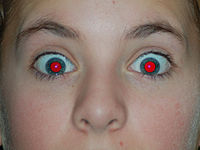
Photo from wikipedia
The availability of direct-to-consumer genetic testing (DTCGT) for age-related macular degeneration (AMD) provides the public with access to disease risk estimations that may be used to guide lifestyle adjustments. However,… Click to show full abstract
The availability of direct-to-consumer genetic testing (DTCGT) for age-related macular degeneration (AMD) provides the public with access to disease risk estimations that may be used to guide lifestyle adjustments. However, AMD development risk is more complex than can be captured by gene mutations alone. The methodologies employed by current DTCGTs to estimate AMD risk vary and are limited in several ways. Genotyping-based DTCGT is biased toward European ancestry and only considers a limited number of genes. Whole genome sequencing based DTCGTs uncovers several genetic variations with unknown relevance, making risk interpretation challenging. In this perspective, we describe the limitations of the DTCGT for AMD.
Journal Title: European journal of ophthalmology
Year Published: 2023
Link to full text (if available)
Share on Social Media: Sign Up to like & get
recommendations!